Using Context to Introduce Parallel, Perpendicular or Neither
This 3 act math task was created using video clips from the Walk Out 3 Act Math Task as a way to get students wondering about parallel and perpendicular lines. Here’s the expectation from the grade 9 academic course in Ontario:
- AG2.04 – identify, through investigation, properties of the slopes of lines and line segments (e.g., direction, positive or negative rate of change, steepness, parallelism, perpendicularity), using graphing technology to facilitate investigations, where appropriate.
After spending some time asking folks on Twitter about how they introduce the concept of parallel and perpendicular lines, I found that we were all doing something pretty similar.
To investigate parallel lines:
- Give students two lines with the same slope in slope/y-intercept form;
- ask them to graph the lines; and,
- ask them what they notice.
The process was pretty similar for perpendicular lines:
- Give students two lines with negative reciprocal slopes in slope/y-intercept form;
- ask them to graph the lines; and,
- ask them what they notice.
After students complete the two investigations, a consolidation would take place. I’ve been doing something similar to this for about 10 years and while it does appropriately address the parallel and perpendicular portions of the expectation through investigation, it felt more like I spoon fed the investigation a bit too much.
While it is pretty easy to find a contextual situation where comparing two parallel lines makes logical sense, I really struggled to find a useful case for comparing two perpendicular lines. You can compare the linear relations representing the cost of two different taxi companies as parallel lines, but it makes absolutely no sense if you try to make a case where the linear relations are perpendicular.
When distance-time graphs came up in my course, I created the Walk Out tasks and finally found a way to at least spark the conversation about parallel and perpendicular lines.
Here it is:
Act 1 – Introduce the Problem
Show this video.
If you have already used the Walk Out 3 Act Math Task with your class, you could probably just show this image:
Ask students what they wonder? What questions come to mind?
Write down some of the questions/ideas that students share.
Hopefully one or more students come up with something like “are they perpendicular or not?”
Once sharing out those questions that come up as a group, I ask them:
Are the lines parallel, perpendicular, or neither? How do you know?
I give them a minute to discuss with their groups.
In grade 9 academic, it might be a good idea to ask the group what it means for two lines to be parallel or perpendicular. What does it look like? What are some examples? This is the first time those concepts come up in the math curriculum in Ontario, so I never assume everyone has an understanding.
Teacher Move: It should be noted that my intention with the video/image is that the lines do appear to be perpendicular, but the scale on the x- and y-axis’ are not equivalent. This gives the viewer the impression that the lines are parallel, but as you’ll see in the next few videos/images, they are not.
Act 2 – Give Some Information
After allowing students to argue it out a bit, I play this video.
Alternatively, here’s the image:
Then, I show them this video to give a bit more information.
Give students more time to discuss and share out. I usually ask students to share out who feels confident in their original guess and who wants to update their prediction.
Act 3 – Show The Answer
Now, I play this video.
Alternatively, here’s the image:
Here are a couple more videos you might want to show as they change the scale to 1:1, but aren’t necessary:
Desmos Activity Builder Activity
While many math teachers have been using the very powerful Desmos Graphing Calculator, the new Desmos Activity Builder is an awesome way to leverage the power of Desmos in a more structured activity. In the past, creating an activity using multiple Desmos graphs involved linking a series of graphs from one to the other. Took quite a bit of time and planning. Now, creating an interactive Desmos Activity takes only a few minutes and it is easy to share with your students and colleagues.
Or, make a copy of the activity so you can edit to your liking!
Here’s some screenshots from the Desmos Parallel and Perpendicular Lines Activity Builder Activity:
Consolidation Activity: Knowledgehook Gameshow
After students finish the Desmos Activity Builder Activity and you’ve taken some time to consolidate the new learning about parallel and perpendicular lines, students can now work on some practice to reenforce the new learning. Check out a Knowledgehook Custom Gameshow that I created with some practice questions related to parallel and perpendicular lines:
Or, just try out the gameshow yourself.
*Note that if you run this Knowledgehook Gameshow with a class account, students have the ability to upload solutions which you can then share via the projector in real-time. The only way to go if you choose to run the activity in class.*
Task Resources:
Here’s all the links in one convenient spot for this activity to go off without a hitch:
Act 1 [video]
Act 2 [scene 1 video | scene 2 video]
Act 3 [scene 1 video | scene 2 video (optional) | scene 3 video (optional)]
YouTube Playlist [All Videos]
Desmos Activity Builder [Try It | Copy It]
Knowledgehook Custom Gameshow [Try It | Copy It]
Make sure to leave a comment if you try out the task! Would love to get some tips on how to make this better.
New to Using 3 Act Math Tasks?
Download the 2-page printable 3 Act Math Tip Sheet to ensure that you have the best start to your journey using 3 Act math Tasks to spark curiosity and fuel sense making in your math classroom!
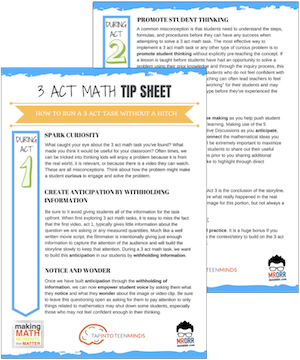
Share With Your Learning Community:

About Kyle Pearce
I’m Kyle Pearce and I am a former high school math teacher. I’m now the K-12 Mathematics Consultant with the Greater Essex County District School Board, where I uncover creative ways to spark curiosity and fuel sense making in mathematics. Read more.
Access Other Real World Math Tasks
Search More 3 Act Math Tasks
Grade 2 [2.B1.1, 2.B1.3, 2.B2.1, 2.B2.2, 2.B2.3, 2.B2.4, Measurement - M1, Number Sense and Numeration - NS1, Number Sense and Numeration - NS2, Number Sense and Numeration - NS3]
Grade 3 [3.B1.5, 3.B2.1, 3.B2.3, 3.B2.7, Measurement - M1, Number Sense and Numeration - NS1, Number Sense and Numeration - NS3]
Grade 4 [4.B2.1, 4.B2.4, 4.E2.5, 4.E2.6, Measurement - M1, Number Sense and Numeration - NS1, Number Sense and Numeration - NS3, Patterning and Algebra - PA2]
Grade 5 [5.B1.7, 5.B2.9, 5.D1.3, 5.D1.6, 5.E2.6, 5.F1.2, 5.F1.5, Measurement - M1, Measurement - M2, Number Sense and Numeration - NS1, Number Sense and Numeration - NS3, Patterning and Algebra - PA2]
Grade 6 [6.B2.12, 6.B2.9, Data Management and Probability - DP3, Measurement - M1, Measurement - M2, Number Sense and Numeration - NS1, Number Sense and Numeration - NS2, Number Sense and Numeration - NS3, Patterning and Algebra - PA1, Patterning and Algebra - PA2]
Grade 7 [7.B1.3, 7.B1.4, 7.B1.7, 7.B2.2, 7.B2.3, 7.C1.1, 7.C1.2, 7.C1.3, 7.C1.4, 7.D1.6, Data Management and Probability - DP3, Geometry and Spatial Sense - GS1, Measurement - M1, Measurement - M2, Number Sense and Numeration - NS1, Number Sense and Numeration - NS2, Number Sense and Numeration - NS3, Patterning and Algebra - PA1, Patterning and Algebra - PA2]
Grade 8 [8.B1.4, 8.B2.5, 8.C1.1, 8.C1.2, 8.C1.3, 8.C1.4, Data Management and Probability - DP1, Data Management and Probability - DP3, Geometry and Spatial Sense - GS2, Measurement - M1, Measurement - M2, Number Sense and Numeration - NS1, Number Sense and Numeration - NS2, Number Sense and Numeration - NS3, Patterning and Algebra - PA1, Patterning and Algebra - PA2]
Grade 9 [9.B3.5, 9.C3.1, 9.C3.2, 9.C3.3]
Kindergarten [k.15.1, k.15.10, k.15.2]
MAP4C [Mathematical Models - MM1, Mathematical Models - MM2, Mathematical Models - MM3]
MAT1LMAT2LMBF3C [Data Management - DM1, Data Management - DM2, Geometry and Trigonometry - GT1, Geometry and Trigonometry - GT2, Mathematical Models - MM1, Mathematical Models - MM2, Mathematical Models - MM3]
MCF3M [Exponential Functions - EF2, Quadratic Functions - QF1, Quadratic Functions - QF2, Quadratic Functions - QF3, Trigonometric Functions - TF1, Trigonometric Functions - TF3]
MCR3U [Characteristics of Functions - CF1, Characteristics of Functions - CF2, Exponential Functions - EF2, Exponential Functions - EF3, Trigonometric Functions - TF3]
MCT4C [Exponential Functions - EF1, Trigonometric Functions - TF3]
MCV4U [Derivatives and Their Applications - DA2]
MDM4U [Counting and Probability - CP2, Organization of Data For Analysis - DA2, Probability Distributions - PD1, Statistical Analysis - SA1, Statistical Analysis - SA2]
MEL4EMFM1P [Linear Relations - LR1, Linear Relations - LR2, Linear Relations - LR3, Linear Relations - LR4, Measurement and Geometry - MG1, Measurement and Geometry - MG2, Measurement and Geometry - MG3, Number Sense and Algebra - NA1, Number Sense and Algebra - NA2]
MFM2P [Measurement and Trigonometry - MT1, Measurement and Trigonometry - MT2, Measurement and Trigonometry - MT3, Modelling Linear Relations - LR1, Modelling Linear Relations - LR2, Modelling Linear Relations - LR3, Quadratic Relations in y = ax^2 + bx + c Form - QR1, Quadratic Relations in y = ax^2 + bx + c Form - QR2, Quadratic Relations in y = ax^2 + bx + c Form - QR3]
MHF4U [Characteristics of Functions - CF3, Exponential and Logarithmic Functions - EL2, Exponential and Logarithmic Functions - EL3]
MPM1D [AG3, Analytic Geometry - AG1, Analytic Geometry - AG2, LR1, LR2, LR3, MG1, MG2, MG3, NA1, Number Sense and Algebra - NA2]
MPM2D [AG1, AG2, AG3, QR2, Quadratic Relations - QR3, Quadratic Relations - QR4, T2, T3]
Functions [F-BF.1, F-BF.3, F-IF.4, F-LE.1, F-LE.2, F-LE.3, F-TF.5]
Geometry [G-C.5, G-C.8, G-C.9, G-GMD.3, G-GMD.4, G-GPE.4, G-GPE.5, G-GPE.7, G-MG.1, G-MG.2, G-SRT.11]
Grade 1 [1.NBT.4, 1.OA.1, 1.OA.6, 1.OA.A.1, 1.OA.B.3, 1.OA.B.4, 1.OA.C.5, 1.OA.C.6]
Grade 2 [2.NBT.5, 2.NBT.B.5, 2.NBT.B.8, 2.NBT.B.9, 2.OA.2, 2.OA.A.1, 2.OA.B.2]
Grade 3 [3.MD.C.5, 3.NBT.2, 3.NF.1, 3.NF.2, 3.NF.3, 3.NF.A.1, 3.OA.1, 3.OA.5, 3.OA.9]
Grade 4 [4-MD.3, 4.MD.1, 4.MD.2, 4.NBT.6, 4.NF.3, 4.NF.5, 4.NF.6, 4.OA.1, 4.OA.5]
Grade 5 [5.B1.7, 5.D1.3, 5.D1.6, 5.MD.1, 5.MD.3, 5.MD.4, 5.MD.5, 5.NBT.2, 5.NBT.3, 5.NBT.6, 5.NBT.7, 5.NF.1, 5.NF.2, 5.NF.3, 5.NF.4, 5.NF.5, 5.OA.1, 5.OA.2, 5.OA.3]
Grade 6 [6.EE.1, 6.EE.2, 6.EE.5, 6.EE.6, 6.EE.7, 6.G.1, 6.G.2, 6.NS.1, 6.NS.3, 6.NS.6, 6.NS.B.3, 6.NS.C.6, 6.NS.C.7, 6.NS.C.8, 6.RP.1, 6.RP.2, 6.RP.3, 6.RP.A.1, 6.RP.A.2, 6.RP.A.3, 6.RP.A.3.C]
Grade 7 [7.EE.3, 7.EE.4, 7.EE.A.1, 7.G.3, 7.G.4, 7.G.6, 7.NS.A.1, 7.NS.A.2, 7.RP.1, 7.RP.3, 7.RP.A.2.B, 7.RP.A.3, 7.SP.2, 7.SP.5, 7.SP.6]
Grade 8 [8.EE.1, 8.EE.5, 8.EE.6, 8.EE.7, 8.EE.8, 8.F.2, 8.F.3, 8.F.4, 8.F.5, 8.G.5, 8.G.6, 8.G.7, 8.G.9, 8.SP.1]
Grade 9Kindergarten [K.CC.A.1, K.NBT.A.1, K.OA.A.1, K.OA.A.2, K.OA.A.3]
Practice [MP.1, MP.2, MP.3, MP.4, MP.6, MP.7]
Statistics & Probability [S-ID.6, S-MD.4]

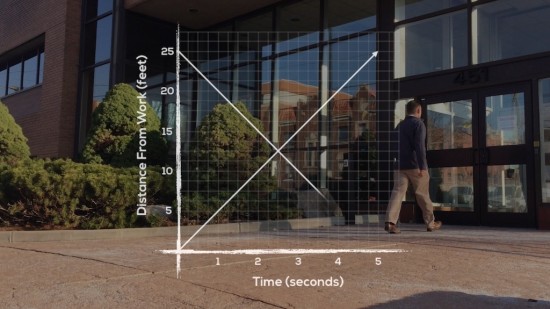
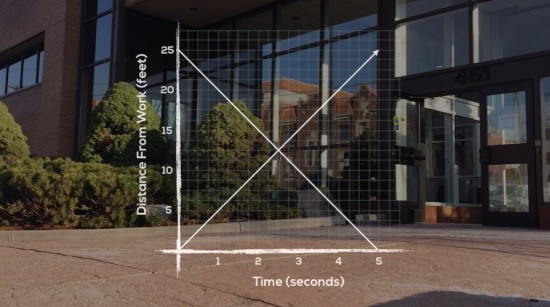
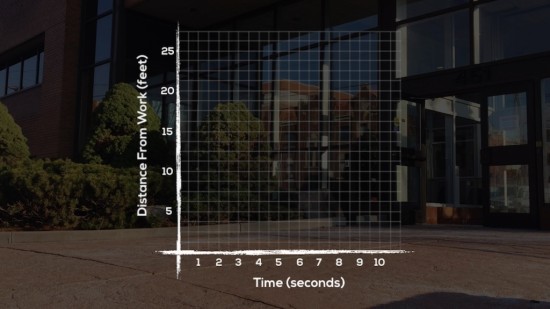
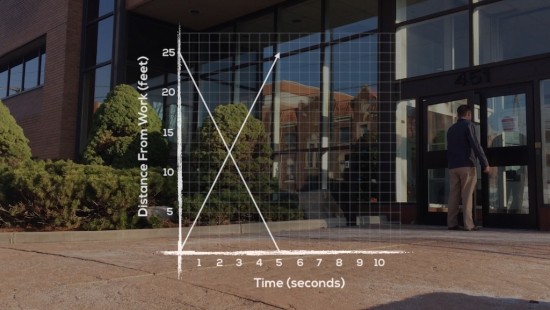

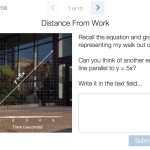
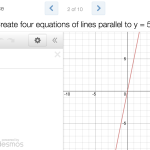
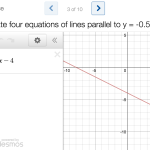
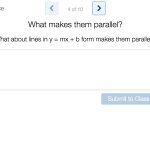
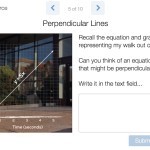
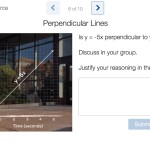
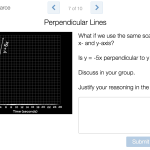
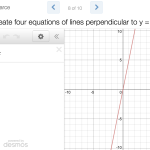
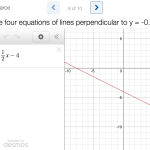
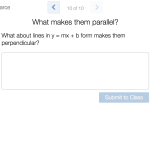
Hey Kyle,
I was just trying to get a copy of the Knowledgehook gameshow that goes along with this activity. The “copy it” link doesn’t seem to be working. Is there any way you can share this with me? Thanks for the great resources, they have been life savers!
Hi Kristen! Just updated the link. Sorry about that. You can grab it here too: https://app.knowledgehook.com/app/Teacher/903465b0-b5c1-e811-a95d-000d3af32666/Content/1e8176f0-c8af-e511-80ed-00155dd5c401//View
If I understand correctly, the non-parallel-ness of the lines is just due to the scale on the axes … but one axis is feet and one is seconds, so there is no apriori scale relating the two axes … since the original picture was clearly using
“5 feet = 1 second” scale, the lines *were* parallel originally. It was only because the scale was changed (arbitrarily) that they became non-parallel … so I feel like it is just a sneaky arbitrary “trick” which makes the students intuitive guess incorrect. No particular scale which makes more sense, so you could say for one scale they are perpendicular, but for any other scale they are not … none has a preferred status … just my take. 🙂